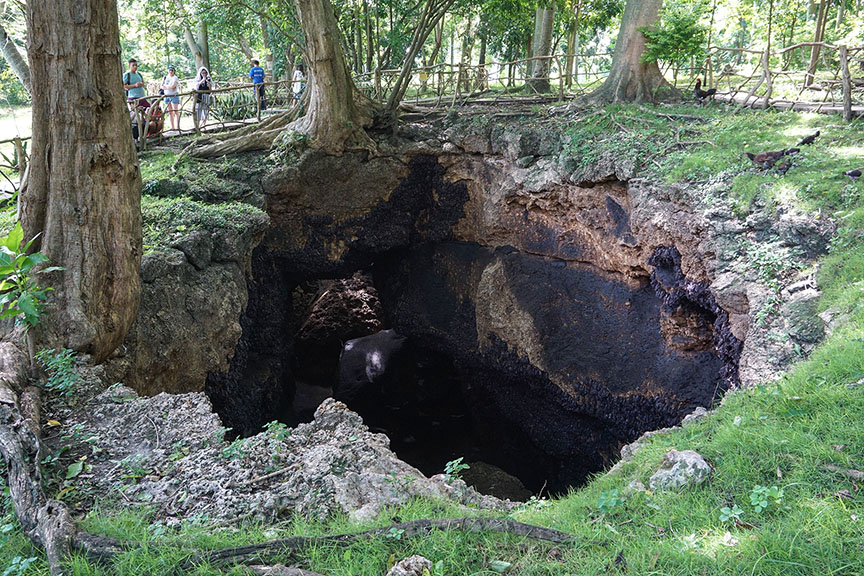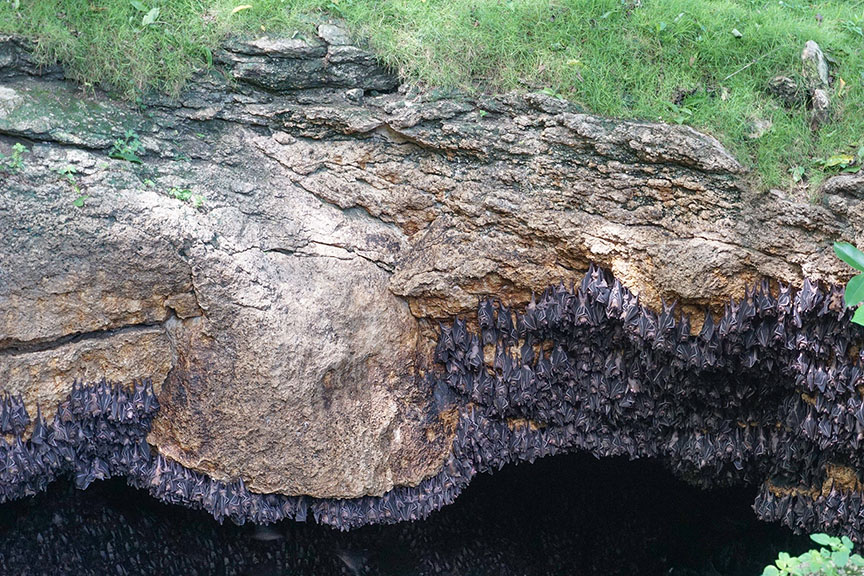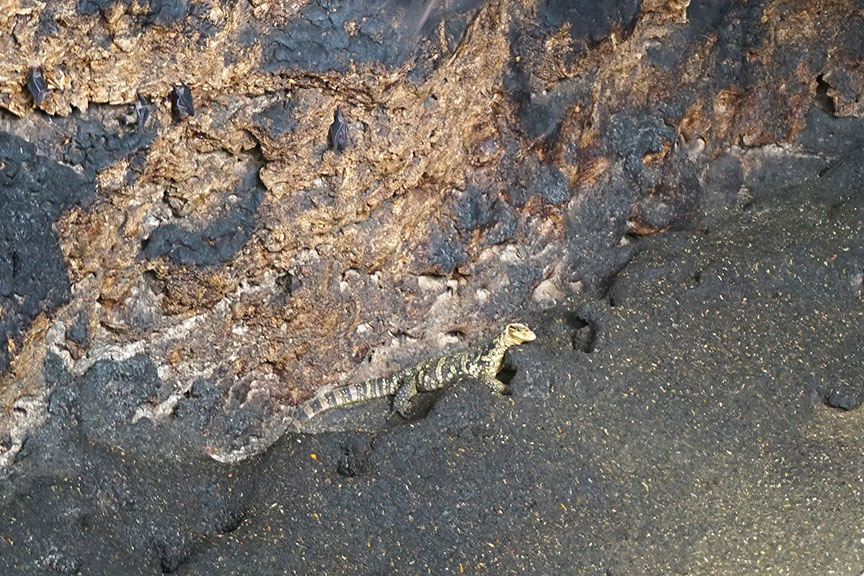DAVAO CITY (MindaNews / 6 June) – The foundation working for bat conservation hopes to start the construction of a chiroptorium, or a man-made bat cave, this year to decongest the 257-square-foot Monfort Bat Cave, which holds the title as the largest single colony of Geoffroy’s Rousette Fruit Bats in the Guinness Book of World Records, as the population of the mammals continues to surge.
 The biggest opening of the 257-square-foot Monfort Bat Cave in Barangay Tambo, Babak, Island Garden City of Samal (Igacos), as photographed on Wednesday (5 June 2019). MindaNews photo by ANTONIO COLINA IV
The biggest opening of the 257-square-foot Monfort Bat Cave in Barangay Tambo, Babak, Island Garden City of Samal (Igacos), as photographed on Wednesday (5 June 2019). MindaNews photo by ANTONIO COLINA IV
Norma Monfort, founder and president of Monfort Bat Cave and Conservation Foundation, Inc., told 12 journalists on Day 2 of the “Learning Field Visit on World Environment Day and Eagle Week” organized by the Philippine Network of Environmental Journalists in cooperation with Vera Files and Internews Earth Journalism Network, that several bats could no longer find a spot to rest on the walls of the cave’s packed cathedral during daytime as their population increased to 2.5 million at the latest from 1.8 million assessed in 2006.
Monfort, who earned the moniker “Mama Bat” for her love of bats, said she had applied for a global grant from the Rotary to help her build the artificial caves to house more bats.
 MAMA BAT. Norma Monfort, who earned the moniker for her love of bats. MindaNews photo by ANTONIO COLINA IV
MAMA BAT. Norma Monfort, who earned the moniker for her love of bats. MindaNews photo by ANTONIO COLINA IV
But Monfort has prepared a plan B in case her application for funding will not get approved.
She said she would ask for donations from companies to give two to three recycled container vans to her foundation and get scientists from Virginia University to replicate the cave conditions.
“It’s tough to maintain because there’s no income. All I have to this day are the ticket sales but these bats are very sacred to me. They always help me in whatever I do because my intention really is to protect them,” she said.
Bats roosting near the cave’s five entrances are vulnerable to the predation of crows while those bats that go down to the ground are vulnerable to lizards, snakes, rats, stray dogs and cats.
She said the population increased partly due to her conservation efforts and to the bats having no specific breeding season. Monfort, who jested to have owned the “biggest brothel” on Samal Island, said her “bats are always fornicating” year-round.
“I see them pregnant in January and December again, walang cycle (no cycle), maybe because there are no disturbances,” she said.
Monfort said the artificial caves are planned to rise at the back of her mango orchard away from the existing bat cave within her family’s 21-hectare estate in Barangay Tambo, Babak, Island Garden City of Samal (Igacos).
She said the construction would be done in the evening, when most of the nocturnal creatures would emerge from the cave and cross Davao gulf to hunt for food in the mainland, to avoid causing disturbances.
“The babies who cannot be carried by the mother are still inside the cave. That’s why, one group comes back at 2 a.m. and I think they come back to regurgitate the foods to their babies,” she said.
 Fruits bats roosting at the rim of the cave are vulnerable to crow predation. MindaNews photo by ANTONIO COLINA IV
Fruits bats roosting at the rim of the cave are vulnerable to crow predation. MindaNews photo by ANTONIO COLINA IV
Collecting guano
She wants that man-made caves to be designed with a technology that can allow her to collect the expensive “guano,” the bat droppings known to be potent fertilizers. According to Bat Conservation International, the guano in caves “support whole ecosystems of unique organisms, including bacteria useful in detoxifying wastes, improving detergents, and producing alcohol and antibiotics.”
“Would you like anybody when you’re sleeping, coming in, getting your stuff there? Ganun din (It’s the same). So, they would leave when they are more vulnerable to predators,” she said.
Monfort said she does not want to make a fortune at the expense of her “sacred” bats even as heaps of uncollected “guano” are just sitting inside her cave.
“I cannot collect. Everybody collects. That’s why most of the caves in The Philippines are empty. This is the only one you can find anywhere. I don’t make money out of the guano,” she said. “Will you rather lose babies?” she asked.
Monfort said she forbade anyone from entering the cave to avoid disturbing the inhabitants inside.
She said a team of experts from Tokyo University wanted to conduct a study on bats but later she had turned it down because she did not want a single bat getting hurt for science.
“I was going to allow them first, of course, my questionnaire was rigorous. I asked what happens if you find diseases transferred or people giving anything to the bats because it could work two ways. What they told me was something like ‘we will cross the bridge when we get there.’ I told them I’m not going to allow. I’m sorry,” she said.
Monfort enlisted the help of Bat Conservation International to help teach anything about bat conservation as she had no idea what to do with the bat cave when she inherited the property from her parents.
In 2004, Monfort filed for the conversion of her property as a conservation area for bats after the government attempted to include her land as part of the Comprehensive Agrarian Reform Program.
 A bayawak sits on a pile of guano, preying on the bats inside the cave. MindaNews photo by ANTONIO COLINA IV
A bayawak sits on a pile of guano, preying on the bats inside the cave. MindaNews photo by ANTONIO COLINA IV
‘Night pollinators’
Monfort said the bats, as night pollinators, play a big role in the fruit production in Davao Region.
She said the bats made “Davao life is here,” a tourism slogan of Davao City, possible because of the abundance of fruits here and emphasized the importance of bats in the quest for peace.
“Without the bats, I will always say there will be war. If you do not have forest you do not have food, we are going to kill each other first, to secure food for ourselves,” Monfort said.
She said the bats are the only pollinators of durian, the so-called “king of fruits,” because their flower buds would open for one hour at nighttime, allowing the bats to pollinate them.
“I will not stop until the region gives the long overdue credit for these bats because you guys are so ambivalent up to now. You eat durian, you eat the fruits, you eat everything, you look at the weather and everything, bountiful harvest, no one thanks the bats, because you think they are pests. They are not. They’re just wonderful,” Monfort stressed. (Antonio L. Colina IV / MindaNews)
